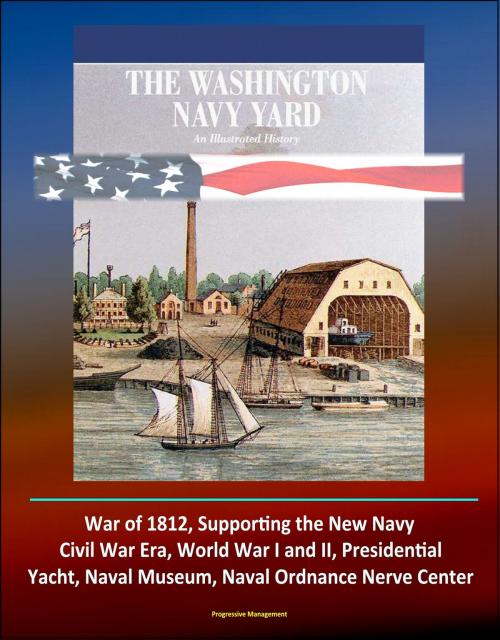The Washington Navy Yard: An Illustrated History - War of 1812, Supporting the New Navy, Civil War Era, World War I and II, Presidential Yacht, Naval Museum, Naval Ordnance Nerve Center
Nonfiction, History, Military, Naval, United States| Author: | Progressive Management | ISBN: | 9781310613906 |
| Publisher: | Progressive Management | Publication: | February 13, 2016 |
| Imprint: | Smashwords Edition | Language: | English |
| Author: | Progressive Management |
| ISBN: | 9781310613906 |
| Publisher: | Progressive Management |
| Publication: | February 13, 2016 |
| Imprint: | Smashwords Edition |
| Language: | English |
Professionally converted for accurate flowing-text e-book format reproduction, this book details the proud heritage of the Navy Yard during the last fifty momentous years. Indeed, this year as we celebrate our bicentennial and face the new millennium, the Washington Navy Yard is undergoing significant growth and revitalization as it takes on a new role as a model for cost-effective support to our Navy's shore establishment. At the same time, the Navy's long-standing commitment to and partnership with the community around the Navy Yard is undergoing a rejuvenation and expansion. The stage is thus set for another era of service to our nation by the Navy Yard.
The Navy Yard is extremely fortunate to have within its walls the Naval Historical Center and its Navy Museum, the display ship Barry, and a variety of artifacts that attest to the yard's key role in the growth of a strong and capable U.S. Navy. The Naval Historical Center's important contribution to the preservation of our rich history is reflected in this excellent book and for this I offer my personal thanks to that fine institution.
Acknowledgments * The Early Years * The War of 1812 * Supporting the New Navy * The Father of Naval Ordnance * Civil War Naval Arsenal and Operating Base * The Post-Civil War Era * Arming a New Navy * Ordnance for a Navy Second to None * Between the World Wars * Ordnance Nerve Center for a Global Conflict * A New Mission for the Navy Yard * Notes
During much of the 19th and 20th centuries, the Washington Navy Yard was the most recognizable symbol of the United States Navy in the nation's capital. The shipyard built a number of the Navy's first warships and repaired, refitted, and provisioned most of the frigates, sloops, and other combatants of the fledgling naval service. The masts and rigging of USS Constitution were a common site on the banks of the Anacostia River. Booming cannon became a routine sound in southeast Washington during the mid-19th century as Commander John A. Dahlgren, "father of American naval ordnance," test-fired new guns for the fleet. The Naval Gun Factory's fire and smoke-belching blast furnaces, foundries, and mills gave birth to many of the fleet's weapons, from small boat howitzers to the enormous 14-inch and 16-inch rifles that armed the naval railway batteries in World War I and the Iowa-class battleships in World War II and the Cold War. Rear Admiral David W. Taylor inaugurated a new era in ship development when he used scientific measurements in his Experimental Model Basin to test the properties of prototype hulls. Before and after World War I, the pioneers of naval aviation experimented in the Anacostia and navy yard facilities with various seaplane types, shipboard catapults, and other equipment that would soon revolutionize warfare at sea.
The Washington Navy Yard has been a witness to history—to the evolution of the United States of America from a small republic, whose ships were preyed upon by Barbary corsairs and whose capital was burned by an invading British army, into a nation of enormous political, economic, and military power and global influence. The Civil War that so dramatically altered American society swirled around and through the Washington Navy Yard. American presidents, first ladies, foreign kings and queens, ambassadors from abroad, legendary naval leaders, national heroes and villains, and millions of citizens have all passed through Latrobe Gate during the yard's 200-year existence.
Professionally converted for accurate flowing-text e-book format reproduction, this book details the proud heritage of the Navy Yard during the last fifty momentous years. Indeed, this year as we celebrate our bicentennial and face the new millennium, the Washington Navy Yard is undergoing significant growth and revitalization as it takes on a new role as a model for cost-effective support to our Navy's shore establishment. At the same time, the Navy's long-standing commitment to and partnership with the community around the Navy Yard is undergoing a rejuvenation and expansion. The stage is thus set for another era of service to our nation by the Navy Yard.
The Navy Yard is extremely fortunate to have within its walls the Naval Historical Center and its Navy Museum, the display ship Barry, and a variety of artifacts that attest to the yard's key role in the growth of a strong and capable U.S. Navy. The Naval Historical Center's important contribution to the preservation of our rich history is reflected in this excellent book and for this I offer my personal thanks to that fine institution.
Acknowledgments * The Early Years * The War of 1812 * Supporting the New Navy * The Father of Naval Ordnance * Civil War Naval Arsenal and Operating Base * The Post-Civil War Era * Arming a New Navy * Ordnance for a Navy Second to None * Between the World Wars * Ordnance Nerve Center for a Global Conflict * A New Mission for the Navy Yard * Notes
During much of the 19th and 20th centuries, the Washington Navy Yard was the most recognizable symbol of the United States Navy in the nation's capital. The shipyard built a number of the Navy's first warships and repaired, refitted, and provisioned most of the frigates, sloops, and other combatants of the fledgling naval service. The masts and rigging of USS Constitution were a common site on the banks of the Anacostia River. Booming cannon became a routine sound in southeast Washington during the mid-19th century as Commander John A. Dahlgren, "father of American naval ordnance," test-fired new guns for the fleet. The Naval Gun Factory's fire and smoke-belching blast furnaces, foundries, and mills gave birth to many of the fleet's weapons, from small boat howitzers to the enormous 14-inch and 16-inch rifles that armed the naval railway batteries in World War I and the Iowa-class battleships in World War II and the Cold War. Rear Admiral David W. Taylor inaugurated a new era in ship development when he used scientific measurements in his Experimental Model Basin to test the properties of prototype hulls. Before and after World War I, the pioneers of naval aviation experimented in the Anacostia and navy yard facilities with various seaplane types, shipboard catapults, and other equipment that would soon revolutionize warfare at sea.
The Washington Navy Yard has been a witness to history—to the evolution of the United States of America from a small republic, whose ships were preyed upon by Barbary corsairs and whose capital was burned by an invading British army, into a nation of enormous political, economic, and military power and global influence. The Civil War that so dramatically altered American society swirled around and through the Washington Navy Yard. American presidents, first ladies, foreign kings and queens, ambassadors from abroad, legendary naval leaders, national heroes and villains, and millions of citizens have all passed through Latrobe Gate during the yard's 200-year existence.















